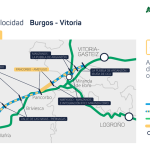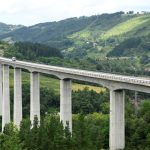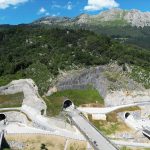 Spain’s Council of Ministers has authorised a EUR 363 million tender for the construction of the first 8.4 km section of the 96.6 km Burgos – Vitoria high-speed line between Pancorbo and Ameyugo. The remaining sections will be tendered by 2026.
Spain’s Council of Ministers has authorised a EUR 363 million tender for the construction of the first 8.4 km section of the 96.6 km Burgos – Vitoria high-speed line between Pancorbo and Ameyugo. The remaining sections will be tendered by 2026.
Due to this decision, Adif will launch the tender which also includes the construction of the platform of the intermediate section, on which the double-track standard-gauge line will be laid. The route is located in the province of Burgos, in northern Spain, between the Piérnigas – Pancorbo and Ameyugo – Manzanos sections, for which the projects are being drafted.
77% of the line alignment runs through a succession of three tunnels and three viaducts. Although the section is short, it raises new technical and engineering challenges given the fact that runs through the the Obarenes Mountains and the Pancorbo Gorge mountainous areas. The tunnels and viaducts will be integrated considering the environment and trest of the facilities and infrastructure that it crosses, such as the A-1 motorway. Among the most notable structures on the route are the continuation of the 4 km long Pancorbo tunnel, through which the line crosses the Montes Obarenes, and the 1.1 km viaduct that, just after the tunnel, flies over the A-1, the SC-BU-7 regional road and the Arroyo de la Llosa.
In November 2024, the Secretary of State for Transport and Sustainable Mobility, José Antonio Santano, has announced that the construction of Pancorbo – Ameyugo section has been approved to enter tendering procedure.
The Burgos – Vitoria high-speed line will be a new standard-gauge double-track and a single-track bypass in Miranda de Ebro, which will allow trains to stop in this town and non-stop traffic outside.
The construction of the line is structured in seven sections, all underway. Following the project’s schedule, the Ministry of Transport, Mobility and Sustainable Mobility (Mitma) is advancing on the projects for the other six to have them all tendered in 2026:
- Burgos – Valle de las Navas railway variant;
- Valle de las Navas – Piérnigas;
- Piérnigas – Pancorbo;
- Ameyugo – Manzanos and integration in Miranda de Ebro;
- Manzanos – La Puebla de Arganzón route; and
- La Puebla de Arganzón – Iruña de Oca.
The Burgos – Vitoria high-speed line will connect the Basque Country to the high-speed network and will improve transport connections and travel times with the centre and the rest of the country, reinforcing territorial cohesion and integration.
The project represents a significant advance in the development of the Atlantic Corridor as the new line provides continuity to the Madrid – Valladolid – Burgos high-speed railway, not only to the Basque Country, where it will connect with the high-speed network currently being built (“Y vasca” – “Basque Y” project) between the three Basque capitals, but also to the French border.
The Ministry of Transport is expecting that the project to build the new line would receive European co-financing through the Connecting Europe Facility (CEF).
These actions may be co-financed by the European Union’s Connecting Europe Facility (CEF).
The Basque Y high-speed rail project will connect Vitoria, Bilbao and San Sebastián reducing travel time drastically. The Vitoria – Bilbao and Vitoria – San Sebastián journey times will be reduced by around 60% while the travel time between Bilbao and San Sebastian will be reduced by 80%.
The new high-speed rail connection will be 180.5 km, not including the access to the capitals and is made of up of two separate branches which includes the 90.8 km Vitoria – Bilbao section, and the 89.7 km Bergara – San Sebastián – French border section.
In order to overcome major difficulties in crossing mountainous terrain, a great number of special structures have to be built. Viaducts and tunnels represent 60% of the Vitoria – Bilbao section, and 80% in the case of the Gipuzkoa branch, including the connection to Bergara node on the Mondragón – Elorrio – Bergara route). The Vitoria – Bilbao section will have a total of 44 viaducts and 23 tunnels.
The average number of unique structures along the entire line, be they tunnels or viaducts, is 70% of the route and includes seven main tunnels and five important viaducts.
Among the infrastructures of the branch line, the Albertia tunnel stands out, which at 4.8 km is the longest structure of the project, and the viaduct over the A-2620 road, 1.4 km long and with piers up to 90 meters high.
In July 2024, the European Investment Bank (EIB) and Adif Alta Velocidad signed a EUR 430 million loan agreement for the construction of the Vitoria/Gasteiz – Bilbao – Donostia/San Sebastián high-speed rail line. The loan also supports the construction of the connection to the Burgos – Vitoria – /Gasteiz high-speed line, the new Vitoria – Gasteiz and Bilbao access points and stations in Vitoria – Gasteiz, Bilbao and Donostia-San Sebastián.
This financing marked the final tranche of a EUR 1 billion loan approved in 2017, increasing to EUR 1.43 billion in 2021.
Share on:








